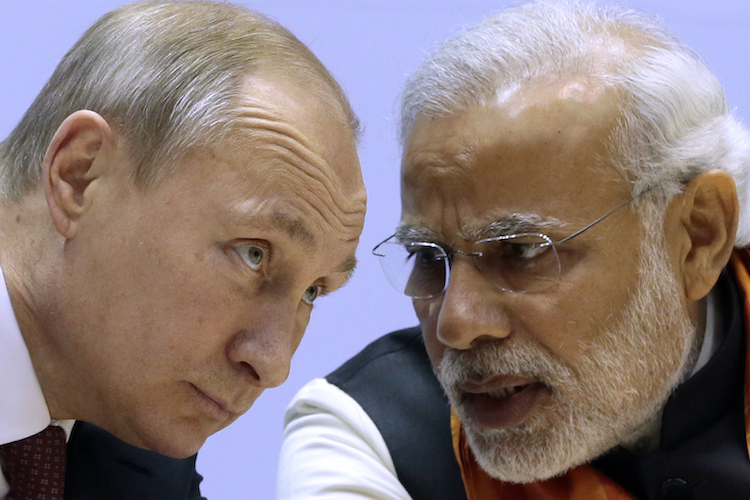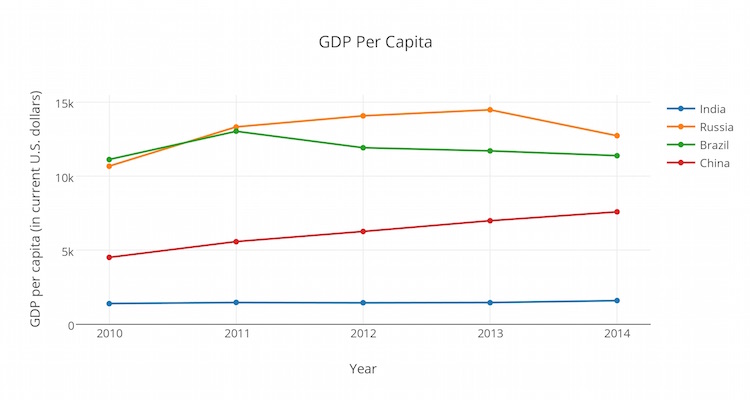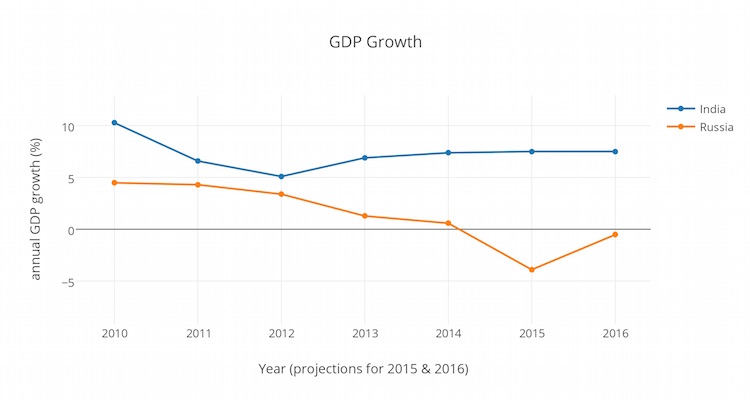International investors have been largely bullish on the Indian economy this year, even as its BRIC counterparts have struggled amid a drop in commodity prices. Why is the country of 1.25 billion people doing better than Russia? In part two of a three-part series, IMR analyst Ezekiel Pfeifer compares Russia to India, which is growing apace but has a long way to go to become a developed nation.

Russian President Vladimir Putin is not as restrained by government institutions as Indian Prime Minister Narendra Modi, who must contend with competing interests while advocating for major economic reforms in India. Photo: Mikhail Metzel / TASS
The economies of emerging nations, including three of the original four BRIC countries—Brazil, Russia, India, and China—have begun to run low on fuel for growth amid a worldwide slump in commodity prices and sluggish gains in the West. Russia’s current crisis had its own unique triggers, such as the cold snap in relations with the U.S. and Europe, but the country also shares certain key attributes with its BRIC counterparts. The Kremlin has made it a priority to associate itself with these nations, citing their shared status as rising powers—but how similar are they really? In order to understand better the obstacles facing Russia and how they compare to those of its supposed peers, IMR will examine the situations in Brazil, India, and China in a three-part series.
In the current turbulent times for emerging economies, the authorities in India have remained upbeat. Their country, the line goes, is safe from the storm winds. “Our fellow Brics all have deep problems,” India central bank head Raghuram Rajan said in mid-September. “Indeed, India appears to be an island of relative calm in an ocean of turmoil.” For investors, who look at statistics like GDP growth and inflation, this is true. One Indian newspaper boasted that the economy is expected to grow upwards of 7 percent in 2015 and in 2016, the most of any BRIC nation, while inflation is down to around 6 percent and the budget deficit to 4 percent. Part of the reason for the expected GDP growth is that India imports many basic raw goods, so the current worldwide rout in commodity prices is expected to save the Indian government about $50 billion a year. This stands in contrast to countries like Russia and Brazil, which rely heavily on income from their exports of oil, gas, and agricultural goods.
Is there a caveat to this rosy picture for India? When comparing the country to its BRIC brethren, there certainly is one, which is the fact that India, while growing quickly, is still light years behind Russia, Brazil, and China in terms of overall development and per capita income. National output per person in Russia stood at $12,735 in 2014, while it was just $1,595 in India, or one-eighth the level of Russia. The country’s 1.25 billion people still do not trade in a unified market system, instead needing to navigate the differing tax regimes of the country’s 29 states in order to conduct commerce. Sixty-eight percent of India’s population lives in rural areas, one of the largest percentages of any country in the world outside sub-Saharan Africa, compared to 46 percent in China, 26 percent in Russia, and 15 percent in Brazil. Hand-in-hand with this rural population is widespread poverty: according to one Indian government analysis, 29.5 percent of the population should be considered poor. Estimates of Russia’s poverty rate vary, but officially about 16 percent of the country is considered poor.

The question is whether India can close this daunting gap between it and its supposed peers—or perhaps even overtake them. As the other BRIC nations have shown, economic change can happen suddenly and extremely quickly. After all, India’s current per capita GDP of around $1,600 is roughly the same amount as Russia had in the year 2000 and China in 2004. But does India have the qualities necessary to experience a similar explosion of growth?

Certain aspects of Indian society make it difficult to envision rapid change. The culture’s rigid caste system remains engrained in huge swaths of the country— for instance, scores of young people have been killed in one conservative northern state for marrying outside their caste—reflecting a deficit of social mobility. By comparison, in Russia, the tumult of the Soviet era and the upheaval that followed the Soviet collapse changed people’s statuses overnight numerous times, creating a relatively more egalitarian society. India’s demographic situation is problematic as well, with a growth rate of 1.25 percent per year, or an increase of about 15.6 million people annually—at the same time as joblessness is an enormous issue. The government reported official unemployment of 4.9 percent in 2013, but the state measures joblessness in many different ways, with results that do not always coincide. A more important statistic may be the fact that 87 percent of Indians say the dearth of job openings represents a “very big” problem. Russia, infamously, has the opposite conundrum, with its population growth having been stagnant for years.
There are precedents for overcoming these kinds of problems, however. Take China’s controversial one-child policy, enacted in 1979 to help the country cope with its own overpopulation crisis. In the preceding decades, the pressures of a mushrooming population brought such tragedies as a famine that caused about 30 million deaths in 1962. (To be fair, India is not seriously considering a similar policy of limiting family size.) And India’s stiff social structures will likely break down further as Internet access spreads throughout the country, a process that has already taken off, with 243 million users in 2014 compared to just 90 million in 2010. On the jobs front, economist C. Fred Bergsten of the Peterson Institute for International Economics argues that India’s economy needs to expand by 8-10 percent per year to create enough jobs for the growing population. He recommends that India mimic China by investing massively in infrastructure, passing liberal economic reforms, and integrating itself more thoroughly into the world economy, including by joining international trade agreements, in order to become a bigger part of the world manufacturing chain.
India’s reform-minded prime minister, Narendra Modi, seems on board with these ideas. But can he carry them out? Whether he is able to do so depends on his ability to navigate—or steamroll—the country’s democratic institutions, and this is part of what distinguishes his challenges from those of Vladimir Putin and Xi Jinping. The Republic of India has been a democracy since its founding in 1950, three years after the country gained independence from Britain, and the prime minister holds most of the executive authority, balanced by independent judicial and legislative branches. Some argue that the likes of Putin and Jinping, like growth-hungry autocrats before them, were effective at expanding their countries’ economies precisely because they had so much power concentrated in their hands, a la the Singapore model of development. There is a marked contrast between the experiences of those countries, the argument goes, and the likes of Brazil, which has been building a genuine democracy since overthrowing a military dictatorship in 1985. Perhaps fittingly, that was the year when Brazil last had a per capita GDP equivalent to India’s current level of $1,600. Brazil currently has per capita GDP of about $12,000, like Russia, meaning that it took the country a full 15 years longer than Russia to reach that level. Effective checks and balances in a government certainly can slow down a country’s economic engine, both by producing political gridlock—as Brazil is experiencing now—and by prioritizing other values, such as political freedoms and human rights, which Russia and China largely ignore.
Whether India’s prime minister can carry out economic reforms depends on his ability to navigate—or steamroll—the country’s democratic institutions.
On the other hand, India’s government is not exactly Norway or Switzerland in terms of democracy. Modi has sought to limit dissent when it suits him. Government forces, for instance, have put intense pressure on one of the country’s best-known rights activists, a woman named Teesta Setalvad, after she began a relentless campaign to hold Modi responsible for deadly riots that killed more than 1,000 people in the state of Gujarat in 2002, when Modi ran the state’s government. The actions against Setalvad have included a fraud investigation, an all-night raid on her home outside Mumbai, and a move to punish the U.S.-funded Ford Foundation, which awarded Setalvad grants. In this case, Modi’s government seems to be borrowing a page straight from Putin’s playbook—the Kremlin has become utterly intolerant of foreign-funded organizations that give money to human rights advocates, saying the groups are controlled by Western governments and seek regime change in Russia. Yet, in Setalvad’s case, the Indian court system has actually come to her defense repeatedly, rejecting a series of accusations by Modi’s Gujarat government. By contrast, the Russian court system is used almost exclusively as a weapon against those who oppose Putin and his allies.
Despite these tactics, Modi has an incredibly high approval rating—87 percent, almost exactly the same as Putin. And some of his constituents say they like his hard-nosed attitude. “There is a saying that he is a selective dictator,” said one businessman from his home region, where Modi became known for favoring aggressively pro-business policies. “In certain segments, we need a dictator,” the man said. Within the government, Modi’s style has not always garnered success. India’s parliament has so far blocked two of his major economic initiatives, one to simplify the national tax system and another to change the laws governing how people acquire land. Putin never faces such problems with Russia’s State Duma, which does his every bidding. Given the relative strength of India’s government institutions, it seems unlikely that Modi will be able to force through reforms quickly.
One key way in which Modi and his country differ fundamentally from Putin and Russia is their strong relationship with the West. India’s highly respected central bank head, Raghuram Rajan, has a Ph.D. from MIT’s Sloan School of Management, served as the International Monetary Fund’s chief economist from 2003 to 2006, and is on the faculty at the University of Chicago. If a Russian economist had a resume like that, they would practically be guaranteed to be ineligible for a prominent position in government, because of the Kremlin’s political game of blaming the West for its problems. (Just see the intense scrutiny paid to Russian opposition leader Alexei Navalny’s brief stint at Yale University as evidence of this.) Modi and Obama recently set up a “hotline” to be able to maintain closer communication, and Modi took a highly publicized trip to Silicon Valley in late September. There he met with Facebook CEO Mark Zuckerburg and Apple CEO Tim Cook, among other tech bigwigs eager to tap the growing Indian market. Contrast that with Russia’s passage of a law requiring tech giants like Facebook and Twitter to store Russians’ user data in Russia, a costly measure that many viewed as a way to pressure the companies to cooperate with the Kremlin when it asks them to—or to get out.
Given that Russia is in the midst of a deep recession and India is benefiting from low commodity prices, its economy has a far brighter prognosis in the near term. But it also has a towering ladder to climb in order to reach even Russia’s level of development, let alone that of Western nations. Like Brazil, which also has functioning democratic institutions, such as independent prosecutors, India’s growth may be slowed by the laborious workings of representative government. That said, Russia may not see growth of more than 1 percent until 2018—even its own central bank says so. For India to catch up to its fellow BRIC members in the foreseeable future, it will require an economic “miracle” on the scale of what China has done, which took place under autocratic rule. But even if India does not accomplish such a feat, its citizens can expect to enjoy steady growth for years to come—and that is significantly better than what awaits Russia.
Follow the links to read part one (Brazil) and part three (China) of the series.

